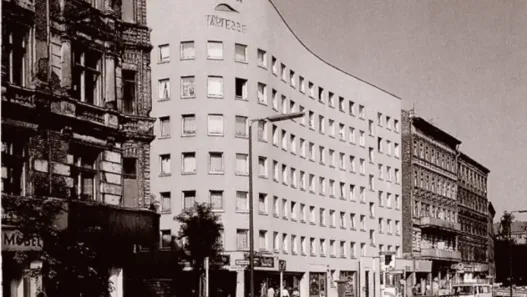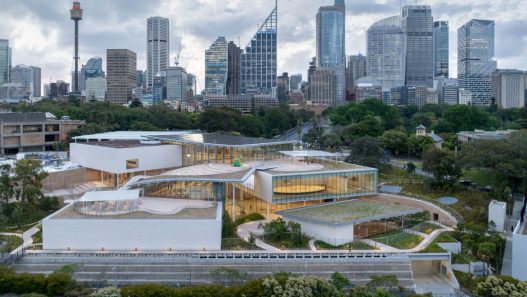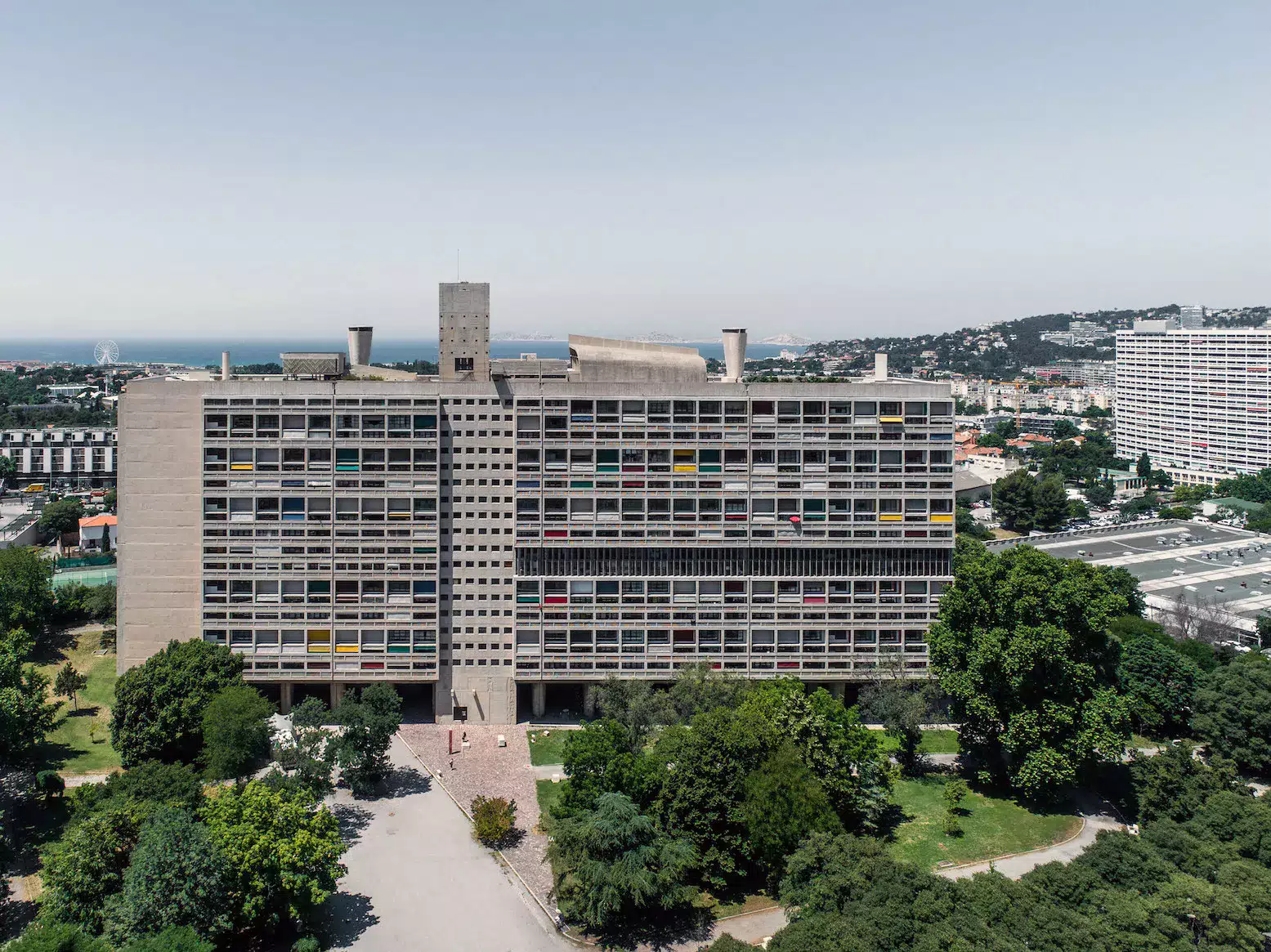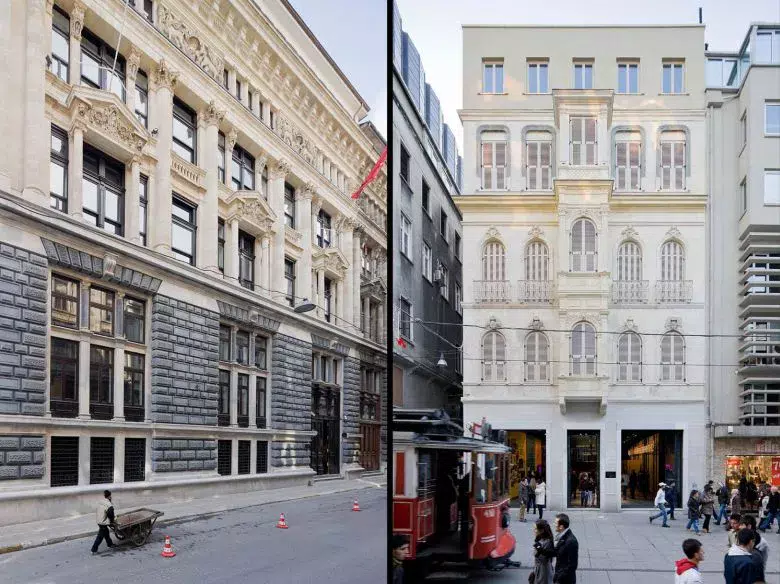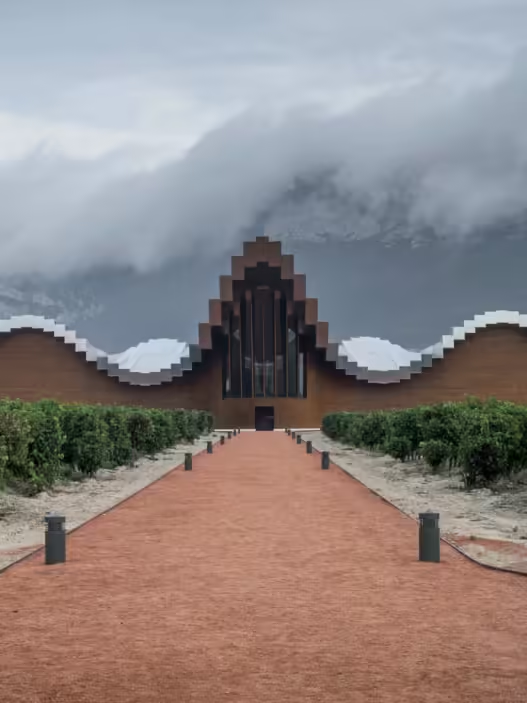One of the pioneering works of modern architecture, S. R. Crown Hall is considered not just a building, but a manifesto of architectural thought and aesthetics. Designed by Ludwig Mies van der Rohe, this iconic building made a significant contribution to the architectural legacy of the 20th century. Located on the campus of the Illinois Institute of Technology in Chicago, Illinois, it is known for its minimalist design, open plan layout and use of industrial materials.
The architectural study of S. R. Crown Hall is important for understanding not only the physical characteristics of a building, but also Mies van der Rohe’s design philosophy and his influence on modern architecture. This building perfectly reflects the balance between function and form, while at the same time exhibiting a structural transparency that interacts with its surroundings.
- Architectural Icon: S.R. Crown Hall is considered an icon of modern architecture and one of the most important buildings of Ludwig Mies van der Rohe’s era.
- Minimalist Design: Architecturally, the building is based on minimalist principles and has an open plan, offering a functional and aesthetically balanced structure.
- Harmony of Steel and Glass: The steel frame and glass walls give the building a modern look, while at the same time providing a sense of lightness and transparency.
- Flexible Interior: The interior of S.R. Crown Hall can be easily adapted to the needs of the users, making it suitable for a variety of events.
- Open Plan: The building offers a column-free layout of the interior spaces, allowing for a wide range of flexibility and use.
- Functional Details: Architectural details, combined with aesthetic concerns, enhance functionality and give the building character.
- Use of Natural Light: The glass walls allow an abundance of natural light into the interiors, which brightens and enlivens the interiors.
- Environmental Responsiveness: The materials used in the architecture and the design approach are notable for environmental sustainability and energy efficiency.
- Educational and Community Space: The building provides an ideal setting for educational and community events, making S.R. Crown Hall more than just an architectural structure, but a community center.
- Cultural and Historical Value: S.R. Crown Hall occupies an important place in the history of architecture and is considered a cultural heritage, along with Mies van der Rohe’s contribution to the modernism movement.
Let’s examine this pioneering building together.
Mies van der Rohe and Modernism
Mies van der Rohe was a German architect who had a great influence on the history of modern architecture. He adopted a simple and minimalist approach in his designs and is one of the leading representatives of the modernism movement.
Mies van der Rohe’s architectural style is known for its clean lines, open plans and extensive use of glass. Following Modernist principles, he combined functionality, simplicity and aesthetics.
Less is MoreMies van der Rohe
Modernism is a movement that emerged with industrial developments and technological advances. This movement moved away from traditional forms and adopted a contemporary aesthetic approach. In accordance with the basic philosophy of the modernism movement, Mies van der Rohe prioritized function and avoided ornamentation.
Mies van der Rohe’s designs include famous buildings such as the Barcelona Pavilion, the Seagram Building and the S. R. Crown Hall. These buildings are characteristic of modernism and are examples of Mies van der Rohe’s architectural style.
Below is a table showing Mies van der Rohe’s impressive career and his importance in the modernism movement:
| Year | Project | Location |
|---|---|---|
| 1929 | Barcelona Pavilion | Barcelona, Spain |
| 1958 | Seagram Building | New York, USA |
| 1956 | S. R. Crown Hall | Chicago, USA |
Mies van der Rohe’s contributions to modernism and his impressive works emphasize his importance in the history of architecture. Buildings such as S. R. Crown Hall are among the best examples of modern architecture.
University of Chicago and Architectural History
S. R. Crown Hall is part of the world-renowned University of Chicago and occupies an important place in the region’s architectural history. The University of Chicago, founded in 1857, is one of the oldest and most renowned universities in the United States. For many years, the university’s architecture department has been home to globally acclaimed teaching and research.
Chicago is also of great importance for art and architecture. With the influence of architects from Europe, a great building and design movement started in the region. While the early buildings were notable for their gothic and improvisational styles, many important architectural works emerged in the 20th century with the influence of the modernist movement. During this period, important buildings such as S. R. Crown Hall represent an important milestone in the architectural history of the University of Chicago.
The University of Chicago played a pioneering role in architectural education, and S. R. Crown Hall is a fascinating representation of that legacy.
Traces in the History of Architecture
The area where the University of Chicago is located has an important place in the history of architecture. In the late 19th and early 20th centuries, the modernist movement that emerged in this region radically changed architecture. During this period, many different architectural styles can be found around the University of Chicago. Different styles such as Gothic, improvisational and modernism defined the architectural traces of this region.
Architecture Education at the University of Chicago
The University of Chicago’s architecture education offers a unique program that encourages creativity and provides students with essential skills. Students gain an in-depth knowledge of historical and contemporary architecture, while keeping abreast of the latest innovations in design and construction processes.
University of Chicago’s Architecture Works
The University of Chicago is home to many important architectural landmarks. Prominent buildings, such as S. R. Crown Hall, are part of Chicago’s architectural heritage and are internationally recognized. They highlight the importance of the University of Chicago’s architecture department and the region’s architectural history.
Key facts about Chicago Üniversitesi and history of architecture can be summarized in the following table:
| University of Chicago | History of Architecture |
|---|---|
| Founded in 1857- | There are various architectural styles in the region, from early to modernist |
| One of the oldest and most renowned universities in the US | Played a pioneering role in architectural education |
| Architecture played a pioneering role in education | Landmarks like S. R. Crown Hall are part of the University of Chicago’s heritage |
The University of Chicago is an educational institution that attracts the attention of the region and the world with its architectural history and important buildings. S. R. Crown Hall is one of these important buildings and represents modern architecture.
Architectural Codes of S. R. Crown Hall
S. R. Crown Hall is a modern architectural masterpiece designed by Mies van der Rohe. In this section, we will explain the architectural codes used in this iconic building and their impact on the design.
Overview of Architectural Codes
The design of S. R. Crown Hall emphasizes the modernist principles and minimalist approach of Mies van der Rohe. The basic architectural codes of the building are as follows:
- Straight Lines: Straight lines dominate the foundation of the building. Straight lines are preferred for the exterior façade of the buildings, interior arrangements and the use of materials.
- Openness: Vertical lines and large glass panels give a sense of spaciousness by integrating the interior with the exterior.
- Asymmetry: S. R. Crown Hall has an asymmetrical plan. This emphasizes the different uses of the space and the interactive spaces.
- Simplicity: A minimalist approach was adopted. Ornaments were avoided and care was taken to ensure that every element in the building was functional.
These architectural codes determine the aesthetic and functional design of S. R. Crown Hall, reflecting Mies van der Rohe’s philosophy of modernism.
Architectural Codes Example: Interior Arrangement
Architectural codes are also at the forefront of interior organization. The table below shows some of the codes used in S. R. Crown Hall and their descriptions:
| Architectural Code | Description |
|---|---|
| Straight Lines | Straight lines are preferred in the layout and furniture selection. |
| Minimalist Color Palette | Colors are used in simple and neutral tones. |
| Open Plan | An open plan that unifies and encourages interaction between spaces. |
| Minimal Furniture | Functional and minimalist furniture emphasizes the simplicity of the space. |
This table shows the architectural codes used in the interior of S. R. Crown Hall and how they were applied.
Interior Design of the Building
The interior design of S. R. Crown Hall is a successful example of modernist approaches. Mies van der Rohe’s minimalist design approach is also reflected in the interior of the building.
Functional and Minimalist Approach
The interior of Crown Hall focuses on the concepts of functionality and minimalism. A large open space offers a free and flexible use. The low number of furniture and objects ensures that the space has a clean and simple appearance.
“Less is more.”
This minimalist approach adapts to the diverse needs of students and faculty. Workspaces and meeting rooms are designed to provide the flexibility needed. Students can develop their projects by having unique and creative workspaces.
Natural Light and Wide Openings
The use of natural light plays an important role in Mies van der Rohe’s designs. In Crown Hall, large glass walls and openings allow natural light to flood the space. This makes the interior bright and spacious, while at the same time ensuring energy efficiency.
The large openings provide a transition between indoors and outdoors and offer an experience in touch with nature. Students and visitors can work and rest effectively in an environment integrated with the landscape and green spaces.
Furnishing and Color Palette
The furnishings and colors used in the interior design have a simple and elegant style in line with the minimalist approach. Modern furniture pieces and neutral colors are preferred. This allows the essential elements of the space to stand out and creates an atmosphere that is easy on the eyes.
Glossy surfaces and glass details add depth and transparency to the space, offering a modern aesthetic. The limited use of colors emphasizes focal points and maintains the calmness of the space.
| Space Design | Features |
|---|---|
| Open Spaces | Provides a wide and flexible use |
| Natural Light | Spreads inside through wide openings and glass walls |
| Minimalist Furniture | Simple and elegant designs are preferred |
| Neutral Colors | Basic colors and natural tones are used |
The interior design of S. R. Crown Hall successfully combines functional and aesthetic aspects. The minimalist approach, combined with wide openings and the use of natural light, provides a comfortable and inspiring environment for its users.
Facade and Material Selection
The façade of S. R. Crown Hall features a minimalist design that is in line with the aesthetics of modern architecture. This choice reflects Mies van der Rohe’s design philosophy, which focuses primarily on material and structural clarity.
The exterior of the building is largely covered with glass panels. These glass panels both increase the impressive amount of natural light inside the building and provide a modern look. Furthermore, the use of glass panels enhances the interaction of the interior with the outside world, providing a unique experience for students and visitors.
Mies van der Rohe took into account important factors such as durability, functionality and aesthetics when selecting the materials used in S. R. Crown Hall. Steel columns and concrete panels were used for the main structure of the building. The steel structure ensures the strength and longevity of the building, while the concrete panels offer an aesthetically elegant look.
We wanted to achieve the most durability with the least possible weight, so we opted for glass panels and steel on the exterior. These choices offer a minimalist aesthetic, minimizing the load on the building.
Material Selection
Mies van der Rohe paid great attention to the choice of materials in the construction of S. R. Crown Hall. The sharp lines of the concrete panels combined with the transparency of the glass panels reflect the basic principles of the modernism movement. In addition, warm and natural materials such as wooden details and natural stones help the interior to create a cozy atmosphere.
| Material | Area of Use |
|---|---|
| Steel | Main structure, frames |
| Concrete | Panels, floors |
| Glass | Facade, windows |
| Wood | Details, interior |
| Natural Stones | Stairs, floors |
Functional Planning of the Building
The S. R. Crown Hall is not only an impressive piece of architecture, but also has a functional planning. Both the indoor and outdoor arrangements have been carefully designed to meet the needs of the users and provide a suitable environment for events.
Many different activities can take place inside the building. It is used as a place where students attend lectures, seminars, presentations and other academic activities take place. It also serves as a venue for exhibitions and events. The interior layout has been carefully planned to create spaces suitable for all these activities.
The functional planning of S. R. Crown Hall takes a flexible approach to meet the needs of its users. It offers multi-purpose spaces for different events and provides spaces that can be optimized. This facilitates the effective use of the building by various user groups.
Furthermore, the outdoor arrangement of S. R. Crown Hall complements the functional planning. The building is surrounded by green spaces and recreational areas so that students and visitors can relax and interact socially. In addition, the accessibility of the building was also a primary consideration, so that people with disabilities can easily use it.
The functional planning of the building provides users with appropriate spaces, making S. R. Crown Hall both impressive and useful.
Innovations Used
S. R. Crown Hall is characterized by many innovative design and construction methods used in modern architecture. In this section, we will examine some of the key innovations used in the building.
1. Building Materials Used
The materials used in the construction of S. R. Crown Hall stand out with their innovative and advanced technology. Modern building materials such as concrete, glass and steel were preferred, resulting in a strong and durable structure.
2. Building Elements and Joining Techniques
The construction techniques used in S. R. Crown Hall are also examples of innovation. The building elements were assembled using a system of pre-fabricated parts. This method enabled the building to be constructed quickly and saved time.
3. Mechanical Systems and Energy Efficiency
S. R. Crown Hall also has innovations in energy efficiency. The mechanical systems used in the building are designed to save energy. Heating, cooling and lighting systems have been optimized using state-of-the-art equipment.
4. Flexible and Multipurpose Design
The innovative design of S. R. Crown Hall prioritizes flexibility and multi-purpose use. The modular and interchangeable structure of the interior spaces allows the building to be adapted to different needs. This feature enables the building to adapt to time and changing requirements.
These innovations show that S. R. Crown Hall is an important milestone in modern architecture. This architecturally pioneering building is notable for its innovative approaches as well as its aesthetics and functionality.
| Innovation | Details |
|---|---|
| Building Materials Used | Modern building materials such as concrete, glass and steel were preferred. |
| Building Elements and Joining Techniques | It was built quickly using a system of pre-fabricated parts. |
| Mechanical Systems and Energy Efficiency | Heating, cooling and lighting systems are designed to save energy. |
| Flexible and Multipurpose Design | The interiors are modular and interchangeable, adapting to different needs. |
Environmentally Friendly Design and Sustainability
S. R. Crown Hall is a building that stands out with its environmentally friendly design and sustainability features. Mies van der Rohe’s understanding of modern architecture aims to minimize environmental impacts and conserve natural resources. These principles are also evident in the design of the S. R. Crown Hall.
The energy efficiency of the building is achieved through natural lighting and ventilation systems. Large glass panels allow natural light to enter and minimize the heat transfer of the building. Thus, the energy consumption of the building is kept low and an environmentally friendly design is presented.
Environmental impact was also taken into account in the choice of materials. Most elements of the building are made of steel, which is a recyclable material. In addition, the panels used on the exterior of the building were selected in accordance with the principles of sustainability.
“The eco-friendly design of S. R. Crown Hall reflects an approach that is sensitive to current environmental issues. This architecturally remarkable building is an example of the best possible application of sustainability principles.”
Green spaces and open spaces are also part of the eco-friendly design. These areas preserve natural vegetation and make an aesthetic contribution to the environment. Furthermore, features such as rainwater harvesting systems and recycling facilities contribute to the sustainability goals of the building.
S. R. Crown Hall is an exemplary building in the world of architecture with its eco-friendly design and sustainability features. Mies van der Rohe’s forward-thinking design offers an approach that is sensitive to future environmental issues.
Social and Cultural Impact of the Building
S. R. Crown Hall is more than just an architectural structure; it has had a profound impact on society and culture. These effects are directly related to the functionality and meaning of the building resulting from its design. S. R. Crown Hall, which is also considered as the symbol of Mies van der Rohe’s modern architecture, redefined the understanding of contemporary architecture and inspired other projects.
“S. R. Crown Hall is one of the leading buildings of the modernism movement. It inspired many architects and designers with its minimalist and functional design.” – Professor Ayşe Yılmaz, Architectural History Expert
The social impact of S. R. Crown Hall has had a profound effect on the University of Chicago’s students, faculty, and local community. The building’s large and versatile spaces provide an environment where people from different disciplines can come together and interact. This fosters a community that encourages discussion, collaboration and creative thinking.
The cultural impact of the building has increased interest in architecture and contributed to the general acceptance of the modernism movement. While S. R. Crown Hall is considered as a center of education and research for architecture students and professionals, it has also become one of Chicago’s tourist attractions.
The social and cultural impact of the building is directly related to its innovative approach to design and functional planning. The open and transparent spaces of S. R. Crown Hall provide an immersive environment that brings people together. This encourages social interaction and cultural exchange in the community.
The impact of S. R. Crown Hall on society and culture demonstrates the power and potential of architecture. It is not only an aesthetic spectacle, but also a place that brings people together and inspires them.
| Social Impact of the Building | Cultural Impacts of the Building |
|---|---|
| Fosters collaboration in the University of Chicago community | Increases interest in architecture |
| Enables the interaction of different disciplines | Contributes to the spread of modernism |
| Encourages discussion and creative thinking | Considered as an architectural education and research center |
| Increases social interaction and cultural exchange | Becomes one of Chicago’s tourist attractions |
Restoration and Preservation of S. R. Crown Hall
S. R. Crown Hall is of great importance for modern architecture and has undergone many restoration and conservation works throughout its history. In this section, we provide information about how S. R. Crown Hall was restored and how it has been preserved.
Restoration Process
The restoration of S. R. Crown Hall was carried out with careful planning and by an experienced team. The restoration work aimed to faithfully restore the building to its original form while meeting modern standards. The restoration process included the following steps:
- A comprehensive assessment and analysis of the structure
- Damage assessment and identification of areas requiring restoration
- Repair of damaged sections in accordance with original materials and details
- Reinforcement of structural elements that need to be protected
- Restoration of interior details with limited intervention
Protection and Maintenance
The preservation and maintenance of S. R. Crown Hall is of great importance to preserve the building for future generations. Conservation and maintenance work includes regular inspections, cleaning and necessary repairs. In addition, protective measures are taken against natural factors that may adversely affect the building. In this way, S. R. Crown Hall can be preserved robustly and aesthetically in the long term.
| Protection and Maintenance Works | Frequency |
|---|---|
| Audits and analysis | Annual |
| Cleaning operations | Monthly |
| Repair and restoration works | When necessary |
The restoration and conservation of S. R. Crown Hall allows us to pass on our architectural heritage to future generations. When this process is carried out in accordance with the original design and details, it makes the building usable today without losing its historical and cultural value.
Other Works of the Architect
Mies van der Rohe has many important works, such as the S. R. Crown Hall. Here are some of them
Farnsworth House
One of Mies van der Rohe’s most famous works, the Farnsworth House is located in Illinois, USA. Characterized by its minimalist design and glass-clad walls, this building reflects Mies van der Rohe’s modern architectural style. Like S. R. Crown Hall, Farnsworth House has an open plan and creates the effect of eliminating the boundaries between indoors and outdoors.
Barcelona Pavilion
Barcelona Pavilion is an exhibition building in Barcelona, Spain. It is considered one of the best examples of Mies van der Rohe’s modernism. The building’s contemporary design, elegant choice of materials and simple forms have attracted great attention in the architectural world. Travertine, one of Mies van der Rohe’s favorite materials used on the facade, gives the building a unique character.
Seagram Building
The Seagram Building in New York is a tower-type office building designed by Mies van der Rohe. The structure rises on a sleek exterior adorned with glass panels and bronze details. With a minimalist design, the Seagram Building harmonizes not only with S. R. Crown Hall on the shores of Lake Michigan, but also with the New York skyline.
Lake Shore Drive Apartments
The Lake Shore Drive Apartments are located on Mies van der Rohe Amber Boulevard in Chicago and are an important example of modern architecture. They are known for their tall glass buildings and open-plan residential units. The building, like S. R. Crown Hall, reflects Mies van der Rohe’s open and functional design approach. These apartment buildings are considered a residential landmark in the city.
139 Fulto Street
139 Fulton Street is recognized by the American Institute of Architects as one of Mies van der Rohe’s notable works in New York City. The building is a modern office building using glass and steel materials and is characterized by its simplicity and transparency. A minimalist design approach has been adopted not only on the exterior but also in the interiors.
Only a few examples are given above, but Mies van der Rohe’s other works are also of great importance in the history of modern architecture. In each of his works, he pushed the boundaries of contemporary architecture by creating a balanced relationship between functionality, minimalism and aesthetics.
Architectural Review – Conclusion
After evaluating the detailed information we have gathered for S. R. Crown Hall Architectural Review, we have gained a better understanding of the features and importance of S. R. Crown Hall. This work of modern architecture by Mies van der Rohe is undoubtedly one of the most important examples of the modernist movement.
S. R. Crown Hall is a building that stands out with its environmentally friendly design and sustainability features. The interior design is remarkable in terms of functionality and aesthetics. Furthermore, the exterior façade and the choice of materials reflect Mies van der Rohe’s minimalist and elegant design approach.
The building’s functional planning, impressive innovations and social-cultural impact are also worthy of study. Although S. R. Crown Hall is similar to other works by Mies van der Rohe, it also stands out with its own unique characteristics.
Overall, S. R. Crown Hall is recognized as an important example of modern architecture. The architectural codes, the remarkable use values and the preservation of the building are also among the results of our review. The S. R. Crown Hall Architectural Review has helped to better understand and appreciate this important building.
Frequently Asked Questions About S. R. Crown Hall
- S. R. Crown Hall nedir?
- S. R. Crown Hall is a famous architectural structure located in the College of Architecture at the Illinois Institute of Technology (IIT). It was designed by Ludwig Mies van der Rohe and is considered one of the leading examples of modernism.
- Where is S. R. Crown Hall located?
- S. R. Crown Hall is located in the city of Chicago in the state of Illinois in the United States of America. More specifically, it is located at 3360 S State St, Chicago, IL 60616.
- What is the architectural style of S. R. Crown Hall?
- S. R. Crown Hall is a classic example of modernist architecture. It reflects the minimalist and functional design principles of Ludwig Mies van der Rohe. Straight lines, glass walls and an open plan scheme are the defining features of the building.
- What is the construction date of S. R. Crown Hall?
- S. R. Crown Hall was built in the early 1950s. It was completed in 1950 and opened in 1956.
- What are the features of S. R. Crown Hall?
- The building is designed as a single open hall and is remarkably column-free. The glass walls allow the interior to integrate with the exterior landscape and reflect Mies van der Rohe’s philosophy of “less is more”.
- S. R. What is the purpose of Crown Hall?
- Originally, S. R. Crown Hall was designed as the main building for the College of Architecture at the Illinois Institute of Technology. Today, it is used for student lectures, exhibitions and other events.
- S. R. Does Crown Hall have a history of restoration?
- Yes, S. R. Crown Hall has been maintained and restored over time. It has been periodically restored in order to preserve the original design of the building and maintain its functionality.
- Is S. R. Crown Hall open to visitors?
- Yes, S. R. Crown Hall is open to visitors. It is usually open during certain hours and is subject to the Illinois Institute of Technology’s visitor policies.
- What is the cultural and architectural significance of S. R. Crown Hall?
- S. R. Crown Hall is an important icon of modernist architecture and showcases the mastery of Ludwig Mies van der Rohe. It is known for its minimalist design and functionality and holds an important place in the architectural world.
- S. R. How can I plan to visit Crown Hall?
- Those wishing to visit S. R. Crown Hall should first check current visiting hours and information on the official website of the Illinois Institute of Technology or local tourism resources.
My Thoughts on S. R. Crown Hall
S. R. Crown Hall stands out as a symbol of Mies van der Rohe’s modern architecture. This extraordinary building draws attention with its simplicity and functionality, while at the same time inspiring the world of architecture. The details of its design and the materials used show how impressive a contemporary approach to architecture can be.
With the construction of Crown Hall, Mies van der Rohe has successfully proven his philosophy that “less is more” in architecture. This building is not only a work of architecture, but also represents the perfect balance between aesthetics and functionality. Both the use of the interior space and the aesthetics of the exterior reflect the power and elegance of modern architecture.
If you haven’t read it yet, you can also check out our Selimiye Mosque / Future Design review…
Architect: Ludwig Mies van der Rohe
Architectural Style: Modernist
Year: 1956
Location: Illinois Institute of Technology, Chicago, Illinois, USA



